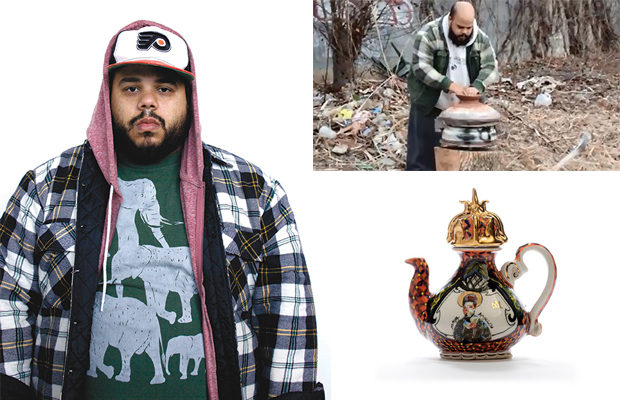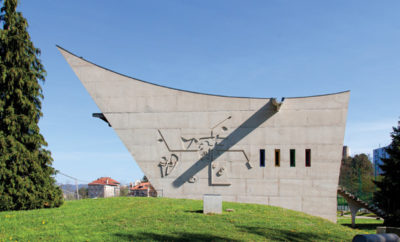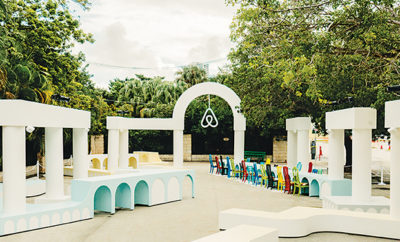 LEFT: The artist Roberto Lugo. TOP RIGHT: With a junkyard as his resource, Lugo throws a pot in Ghetto Is Resourceful, 2014, his video performance piece. BOTTOM RIGHT: Self-portraits come in many forms for Lugo: Roberto Lugo and Celina Ayala, 2015, a recent teapot.
LEFT: The artist Roberto Lugo. TOP RIGHT: With a junkyard as his resource, Lugo throws a pot in Ghetto Is Resourceful, 2014, his video performance piece. BOTTOM RIGHT: Self-portraits come in many forms for Lugo: Roberto Lugo and Celina Ayala, 2015, a recent teapot.
Feature
Roberto Lugo Is Changing the World, One Teapot at a Time
Chances are you haven’t seen portraits of hip-hop legends the Wu-Tang Clan or artist Frida Kahlo painted on a porcelain teapot. That is, unless you’re familiar with the work of Roberto Lugo, thirty-four, a ceramics star on the rise. Lugo’s work combines his Puerto Rican heritage, graffiti—learned from the streets of his Philadelphia upbringing—and his love of porcelain. Of blending street art and fine china, he says, “my work and my life are really about bringing my culture and my background to places where they don’t necessarily belong.”

The charged Confederate Tea, 2014, joins Frederick Douglass and Notorious B.I.G. (far right) with a Confederate flag.
Lugo didn’t take his first ceramics class until the age of twenty-five, which he recalls, “was the first time in my life anybody had ever really said I was good at something,” but today, nine years later, his career is in full swing.

With a junkyard as his resource, Lugo throws a pot in Ghetto Is Resourceful, 2014, his video performance piece.
He was recently appointed professor of art at Marlboro College in Vermont, and Wexler Gallery will be exhibiting his work at New York’s Collective Design in May, its second year showing his work at the fair. “I felt that he was doing something that I’d never seen before, with the combination of clay, graffiti, and spoken word,” Lewis Wexler says. “The work goes deeper than just the imagery and the pot, and that’s what makes it compelling.”

Michael Brown, one of four portraits on the urn, We Are All Kings, 2015.
Led by ceramics, Lugo’s body of work includes activism, community engagement, poetry, and a variety of media. To illustrate the ideas behind it, he points to his video performance piece, Ghetto is Resourceful. Filmed in an abandoned lot near his childhood home, in it Lugo creates a hand-thrown pot from the junkyard contents. The clay is earth sifted from trash, moistened with the remnants of a 40-ounce beer; the makeshift potter’s wheel is pieced together with items including scrap wood, a spoke and hubcap, tape, rope, and an empty tin can. Narrated with powerful memories of family, poverty, racism, and the profound role that “being a potter of color” has had in his life, the video is a raw self-portrait.

Self-portraits come in many forms for Lugo: Roberto Lugo and Celina Ayala, 2015, a recent teapot.
Yet, while his background is central to his work, Lugo is equally influenced by the history of ceramics. Harnessing the aristocratic language of porcelain, traditional forms and ornament are his point of departure. Using portraiture, the artist pulls widely from temporary and historical figures: an urn features Erykah Badu and Sojourner Truth, a teapot joins Maya Angelou and Desmond Tutu. Lugo also draws particular inspiration from what he calls ceramics’ “hidden heroes,” women working in porcelain in the late nineteenth century. Adding his own perspective to the long tradition of china painting, he says, “I really like leaving space for a little intuitive decision making. That lends itself back to my experience as a graffiti artist, where I would adjust what I was doing to a wall that I was at.”

Century Vase III: American Refugees, 2015, is the third in Lugo’s ongoing series inspired by the original 1876 Century Vases manufactured by the Union Porcelain Works.
Soft-spoken and earnest in person, Lugo speaks with equal facility on both hip-hop and ceramic history. The spark, he recalls, that led him to combine his background with traditional porcelain was seeing one of the pair of Century Vases by the Union Porcelain Works exhibited at the 1876 Centennial Exhibition in Philadelphia. “I loved how it was made to represent the last hundred years in American ingenuity,” he says. “I was thinking to myself, ‘What if I were to talk about the last hundred years and what it means to be a Puerto Rican, or what it means to be African American?’” With that, he realized, “If I want to include my culture in the grander scheme of things, I should be referencing culture that already exists and then putting it my way—contributing a verse to the great play.” Lugo has since taken on his own series of Century Vases, the most recent of which interprets one hundred years of refugees.

As pandas often serve as his animal alter-ego, Panda Eats Shoots and Leaves, 2011. Courtesy of the artist.
Another recent work, We Are All Kings, depicts Michael Brown, Trayvon Martin, Eric Garner, and Rodney King. “The idea was not to necessarily make a statement, but to say that these people are worthy of having an urn, these people are equal to others,” Lugo says. The urn, more than two feet tall and poignant to the point of heartbreak, is topped with a golden crown that takes on multiple meanings: a visual quote of the crown-shaped dashboard air fresheners of Lugo’s youth—a status symbol in urban Philadelphia; a nod to the crown used by Jean-Michel Basquiat; and an allusion to rapper KRS-One’s declaration of equality in his seminal song “Criminal Minded.”

Maya Angelou and Desmond Tutu, 2015.
Lugo has also begun to use imagery that might be deemed culturally at odds. In Confederate Tea, one from a series, portraits of Frederick Douglass and Notorious B.I.G. adorn the sides while a Confederate flag, wrapped gangster-style, becomes its spout. “In some ways,” he says, “I take away the power of a symbol by using it myself.” Self-portraits are an anchor for the artist. Taking many guises, they are his way, quite literally, to insert himself into the conversation, “I’ll put something that represents ‘them’ and then I’ll put my face on it,” he explains, “with the idea that I’d literally like to sit down with it for a cup of tea with them.” Figurines, inspired by those made by Minton and Royal Doulton, become his means to explore his more personal struggles, in particular obesity, with works including The Day My Belt Broke and Doughnut Handcuffs. Pandas often appear in Lugo’s work, his spirit animal stand-in. “The panda is this cuddly animal that you want to hug, but it’s vicious,” he says. “Oftentimes, people make assumptions that I can be intimidating, and actually I’m the opposite.”

Self-portraits come in many forms for Lugo: The Day My Belt Broke, 2013, Lugo’s approach to the figurine and an early work. Courtesy of the artist and Jim Walker.
Indeed, Lugo sees his work as leading the way for the next generation. “I really love to go back to Philly and show people, ‘Hey, I make things with clay and I’m really happy doing it,’” he says. “Which is a lot different than saying, ‘Hey, I’m a basketball player, and I do this thing that’s almost impossible for you to do.’” With “This Machine Kills Hate” tagged on his potter’s wheel, Lugo has a bright vision for the future: “I’m hoping that instead of people thinking that I’m somehow dissing ceramic culture, what I’m trying to say is that I’m in love with that history, but I also want my culture to be included in the discourse.”
Except as noted, all images by KeneK Photography/Courtesy of Wexler Gallery, Philadelphia, PA.












